Free C90.06 Exam Questions - Arcitura Education C90.06 Exam
Arcitura Education C90.06 Exam - Prepare from Latest, Not Redundant Questions!
Many candidates desire to prepare their Arcitura Education C90.06 exam with the help of only updated and relevant study material. But during their research, they usually waste most of their valuable time with information that is either not relevant or outdated. Study4Exam has a fantastic team of subject-matter experts that make sure you always get the most up-to-date preparatory material. Whenever there is a change in the syllabus of the Cloud Architecture Lab exam, our team of experts updates C90.06 questions and eliminates outdated questions. In this way, we save you money and time.
Arcitura Education C90.06 Exam Sample Questions:
Cloud Service A is hosted by Virtual Server A, which is hosted by Hypervisor A on Physical Server A. Virtual Server B is hosted by Hypervisor B on Physical Server B.
Cloud Service Consumer A accesses Cloud Service A and the request is intercepted by an SLA monitor (1). Cloud Service A receives the request (2) and accesses Cloud Storage Device A and Cloud Storage Device B (3).
Cloud Service Consumer A belongs to Organization A, which is leasing all of the IT resources shown in the figure as part of an laaS environment.
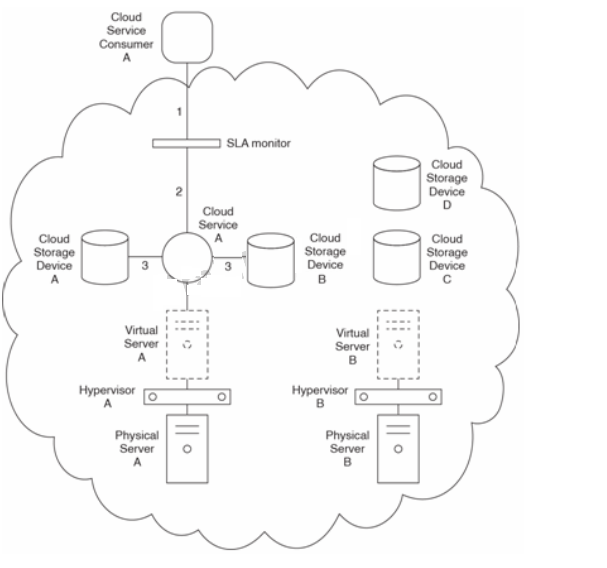
Cloud Storage Device B has a higher performance capacity than Cloud Storage Device A. Cloud Storage Device C has a higher performance capacity than Cloud Storage Device B. The requests being received by Cloud Service A from Cloud Service Consumer A have recently increased in both quantity and in the amount of data being queried, written and read from Cloud Storage Device A. As a result, Cloud Storage Device A's capacity is frequently reached and it has become unstable at times, timing out with some requests and rejecting other requests.
Cloud Storage Device C is used by Organization A to store backup data on a daily basis. One day, a hardware failure within Cloud Storage Device C results in the permanent loss of data.
Organization A requires a system that will prevent this type of failure from resulting in data loss.
The cloud provider is planning to implement a routine maintenance schedule for Cloud Storage Devices A, B, and C and issues a notice stating that the new schedule will start next week. An outage of 30 minutes every Thursday and Sunday at 8:00 PM is needed for the maintenance tasks. Upon hearing this, Organization A complains that they cannot afford to have Cloud Storage Devices A and B become inoperable, especially not during the weekdays.
Which of the following statements describes a solution that can address Organization A's issues?
Cloud Service A accesses LUN Aon Cloud Storage Device A when it receives requests to process data from cloud consumers. Cloud Service A is hosted by Virtual Server A. The usage and administration portal can be used to access and manage the data in Cloud Storage Device B, which is also hosted by Virtual Server A. Virtual Server A is further hosted by Hypervisor A, which resides on Physical Server A. Virtual Server B is part of a virtual server cluster hosted by Hypervisor B. which resides on Physical Server B. Physical Server C is not in use and does not yet have an operating system installed.
Cloud Service Consumer A sends a request to Cloud Service A (1), which accesses data in LUN Aon Cloud Storage Device A (2). Cloud Consumer B uses the usage and administration portal to upload new data (3). The data is placed in LUN B on Cloud Storage Device B (4).
Cloud Service Consumer A and Cloud Consumer B belong to Organization A, which is leasing Virtual Server A and Virtual Server B from the cloud provider. Organization A also proceeds to lease Physical Server C as part of a new laaS agreement it signs with the cloud provider.
Organization A wants to provision Physical Server C with a number of legacy systems that cannot be deployed on virtual servers. However, when it attempts to do so, it realizes that its laaS package only provides Physical Server C as an out-of-the-box hardware server without anything installed on it. In order to deploy its legacy systems Organization A requires that Physical Server C first has an operating system installed, but it has no means of remotely provisioning Physical Server C with an operating system.
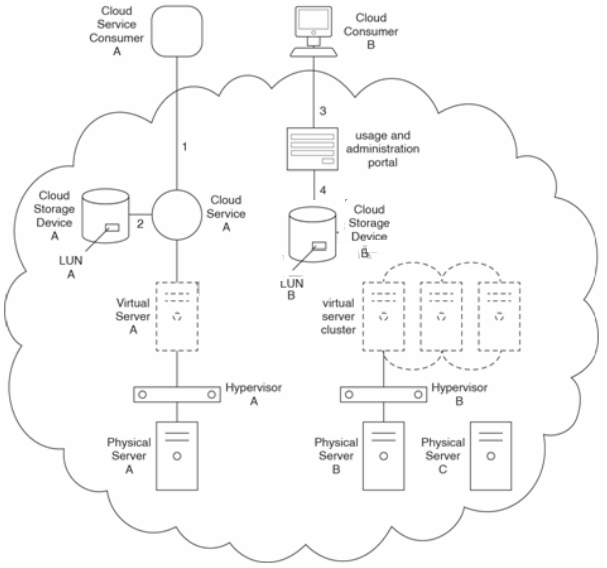
Organization A would like to deploy two of its legacy systems on Virtual Server A and to further extend Cloud Service A's functions so that it can be used as an external interface for cloud service consumers to access legacy system features. Additionally, Organization A would like to deploy three of its mission-critical legacy systems on Virtual Server B in order to take advantage of the additional performance and failover benefits provided by the virtual server cluster that Virtual Server B is part of. Each of the five legacy systems is comprised of dozens of components that need to be installed individually. Instead of manually installing each component of each legacy system, Organization A would like to customize workflows that can automate these deployment tasks.
During the first few months of working with its cloud-based legacy systems. Organization A receives a number of complaints from users that the cloud-based legacy systems are at times behaving erratically. However, when cloud resource administrators with Organization A review the cloud provider's reports that log usage, downtime and other runtime characteristics, they do not find any indication of erratic behavior or any other comparable problems. After some further investigation, the cloud resource administrators determine that the nature of the erratic behavior is specific to proprietary features of the legacy systems and is therefore not monitored or logged by the cloud provider's standard audit monitor, pay-per-use monitor or automated scaling listener.
The cloud resource administrators recommend that a new service agent be developed with features customized to monitor the legacy systems.
Which of the following statements provides a solution that can address Organization A's requirements?
Cloud Service A is installed on Virtual Server A and the database it accesses is located on Cloud Storage Device A. Both Virtual Servers A and B are hosted by Hypervisor A. Requests from cloud
service consumers are intercepted by an automated scaling listener that automatically routes subsequent requests to additional instances of Cloud Service A whenever the given usage of an instance exceeds two concurrent requests.
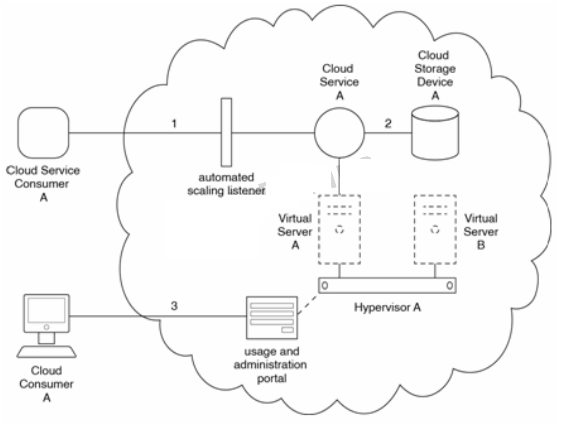
Cloud Service Consumer A accesses Cloud Service A (1), which either sends a query or a read/write request to a database on Cloud Storage Device A (2). A usage and administration portal is available, enabling Cloud Consumer A to view the billing and usage history of Virtual Servers A and B (3).
Cloud Service Consumer A and Cloud Consumer A are owned by Organization A. which performs several tests on the cloud architecture that produce the following results:
A stress test is performed to generate workloads on Virtual Servers A and B to gauge their load capacity. This test reveals that both virtual servers have firm workload thresholds. If the workload capacity on either virtual server reaches its threshold, further processing requests are rejected.
An availability test shows that Cloud Service A becomes unavailable whenever Hypervisor A crashes.
A security test is carried out during which the cloud architecture is accessed by a malicious cloud consumer that disables the path used by Cloud Service A to access Cloud Storage Device A, thereby causing all subsequent cloud service consumer requests to be replied to with data access errors.
Which of the following statements describes a solution that addresses the concerns raised by the three tests?
Physical Server A hosts Hypervisor A which hosts Virtual Server A, Virtual Server B and an active cluster comprised of three virtual servers. Virtual Server A hosts Ready-Made Environment A. Ready-Made Environment A uses Cloud Storage Device A to store data related to the ready-made environment and its users. Cloud Service A is hosted by a high-availability (HA) virtual server cluster. Hypervisor A is a cluster-enabled hypervisor.
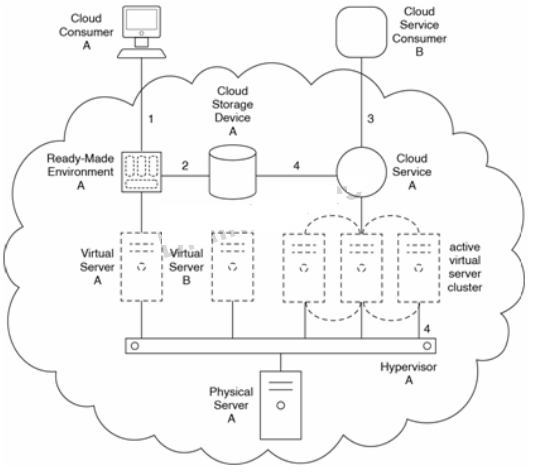
Developers access Ready-Made Environment A to work on the development of a new solution (1).
During this usage. Ready-Made Environment A regularly reads and writes data to Cloud Storage Device A (2). Cloud Service Consumer B accesses Cloud Service A (3). Cloud Service A queries data residing in Cloud Storage Device A in response to processing requests from Cloud Service Consumer B (4).
Hypervisor A is made part of a cluster of hypetvisors. Ready-Made Environment A, which is still hosted by Virtual Server Aon Hypervisor A, subsequently becomes unexpectedly unavailable. It then takes twenty minutes to pass before Virtual Server A and Ready-Made Environment A become available again on Hypervisor B (a hypervisor that is also part of the hypervisor cluster). This delay is considered unacceptable by Cloud Consumer A. Furthermore, after being relocated
to Hypervisor B, Virtual Server A is unable to connect to the network. By the time the cloud provider rectifies this second problem, Cloud Consumer A experiences a total of two hours of downtime.
Which of the following statements describes a solution that can minimize or entirely avoid a delay for the runtime relocation of Ready-Made Environment A?
Virtual Server A and Virtual Server B are hosted by Hypervisor A, which resides on Physical Server A. Virtual Server A hosts Cloud Service A. Virtual Server C. Virtual Server D, Virtual Server E and Virtual Server F are hosted by Hypervisor B on Physical Server B. Physical Server C, which hosts Hypervisor C, is currently not being used.
Cloud Service Consumer A accesses Cloud Service A (1), which accesses files stored in a folder on Virtual Server A (2). Cloud Consumer B uses Proprietary User Portal A to administer legacy software (not shown) installed on Virtual Server D (3). Proprietary User Portal B and Proprietary User Portal C are also available for accessing additional legacy systems located on Virtual Server F; however, they are not often used.
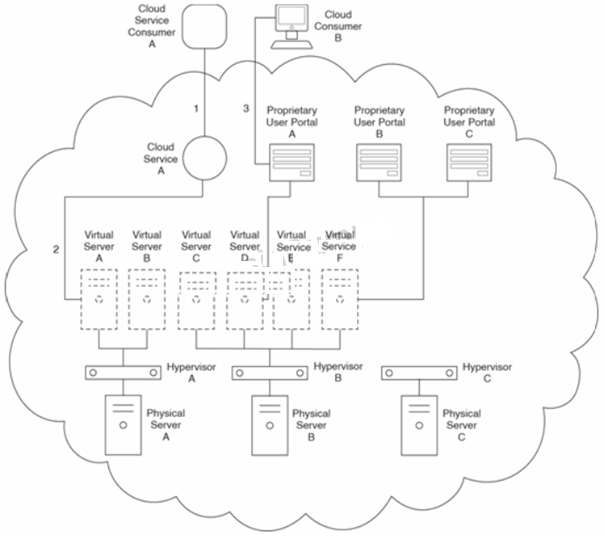
The cloud shown in the figure is a private cloud. Department A and Department B share IT resources within the private cloud and are part of the same organization. Cloud Service Consumer A belongs to Department A and Cloud Consumer B belongs to Department B.
During routine access of Cloud Service A by Cloud Service Consumer A, the Department A cloud resource administrator is notified that a hardware fault is occurring within Physical Server A that will soon cause it to fail. The cloud resource administrator scrambles to arrange for Cloud Service A to be relocated but is unable to do so before Physical Server A does fail. It takes several more hours of downtime until, with the cooperation of the cloud provider, the Cloud Service A implementation is successfully moved to Physical Server C and made live again. Managers at Department A demand that a system be put in place to avoid this scenario in the future.
Cloud Service A was initially developed specifically for Department A's Cloud Service Consumer A. However, recently Department B has indicated that it will be developing its own cloud service consumer that will also need to regularly access Cloud Service A. After this new cloud service consumer is deployed, both Department A and Department B experience occasional runtime errors when their cloud service consumers attempt to access Cloud Service A at the same time.
Cloud Service A accesses a legacy system on Virtual Server A that requires regular updates and patches to stay current. Each time the legacy system is updated, Cloud Service A needs to undergo an update as well, during which it needs to be temporarily unavailable. Department A managers ask the cloud provider to extend the cloud architecture so that a duplicate, secondary implementation of Cloud Service A can be made available while the primary implementation undergoes a maintenance update.
Which of the following statements provide a solution that can adequately resolve all of Departments A and B's issues?



Currently there are no comments in this discussion, be the first to comment!